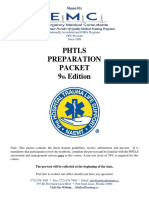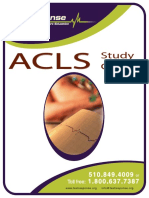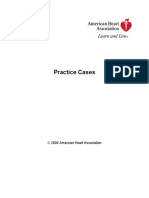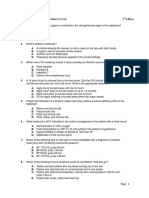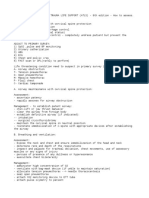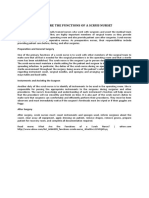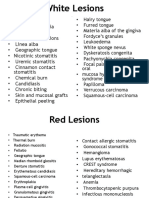PHTLS Study Guide/Notes
PHTLS Study Guide/Notes
Uploaded by
Ideas ManifiestasCopyright:
Available Formats
PHTLS Study Guide/Notes
PHTLS Study Guide/Notes
Uploaded by
Ideas ManifiestasOriginal Title
Copyright
Available Formats
Share this document
Did you find this document useful?
Is this content inappropriate?
Copyright:
Available Formats
PHTLS Study Guide/Notes
PHTLS Study Guide/Notes
Uploaded by
Ideas ManifiestasCopyright:
Available Formats
PHTLS Study Guide/Notes
“Priority of care in the critical multi-system trauma patient is rapid identification and
management of life-threatening injuries.”
“The most common basis of life-threatening injuries is lack of adequate tissue
oxygenation, which leads to anaerobic metabolism.”
▪ Primary Assessment
o “ABCDE” – know and understand what constitutes each part of the
primary assessment
▪ Secondary Assessment – AKA - the “head-to-toe” assessment
o Objective: “identify injuries or problems that were not identified during
the primary assessment”.
o These injuries should be minor and not life-threatening.
▪ Bleeding Control
o Steps of bleeding control
o Use of a tourniquet
o Place of hemostatic agents in bleeding control.
▪ Types of shock:
o Know the types of shock and characteristics of each.
▪ Example: Neurogenic shock vs. Hemorrhagic shock
o Know what system initially response to compensate for blood loss
▪ Pneumothorax and Flail Chest - Signs/symptoms and treatment
▪ Brain injuries:
o Types and characteristics of each type
o Understand secondary brain injury
o Understand “controlled hyperventilation” and risks of hyperventilation
▪ Fluid resuscitation in Trauma:
o Why don’t we do excessive fluid resuscitation anymore?
o What should guide our fluid resuscitation?
o What should be our target blood pressure be in a trauma patient?
▪ Burn care and treatment
o Wet vs. dry dressing
▪ Airway management of the trauma patient
o Suctioning
o What is the main goal?
▪ ETCO2 – it’s place in airway care of the trauma patient
▪ Understand the new standards of “Selective Spinal Immobilization”
▪ Trauma arrest – when to work vs. when to call without working
▪ What are the PHTLS “Golden Principles of Trauma Care”?
Things we found on the PHTLS Final Exam that seem confusing or weird:
• More geriatric trauma patients die from falls than ANY other mechanism even if there
are other mechanisms that seem more dangerous. Read the question—it wants to
know a statistic and so realize that there are LOTS of geriatric falls.
• The scoop stretcher is a favorite of the PHTLS people for moving patients quickly to a
backboard even though you don’t see that much in our area.
• Remember to remove the occlusive chest seal when your patient develops a tension
pneumo BEFORE you needle the chest. A miracle might happen and the removal of
that seal might actually lead to a venting of the built up pressure. Chucks and clots
and dirt and shirt pieces might actually move out of the way and allow that air bubble
to escape. Miracles happen in PHTLS just like they do in ACLS (everyone lives!!!).
• A patient with an epidural hematoma tends to have a loss of consciousness and then a
lucid interval and then deterioration according to PHTLS legend.
• Dermatomes matter if you want to get #39 correct. Know the nipple line and belly
button line and where the corresponding injury is for those. Know that C3-4-5 keep the
diaphragm alive.
• Blunt trauma patient who is pulseless and apneic on your initial assessment is non-
viable according to PHTLS.
• Breathing should not be noticeable—not labored, not noisy. If you notice it, deal with it.
• Hemostatic agents help control bleeding and they are cool per PHTLS.
• Usually we make fun of people that use weird (although correct) medical terminology
like bradypnea but PHTLS has weird people writing questions.
• When suctioning your PHTLS patient, don’t be stuck in the ridiculous Irrational
Registry rules—suction it out even if that takes longer than some magical and fictitious
time limit.
• When your patient is herniating, you should use controlled hyperventilation at a rate of
___ for adults and ___ for kids even though you know that you may cause some
cerebral vasoconstriction—the guy is going to croak if you don’t do something even if it
has a horrendous side effect.
You might also like
- Phtls 10th Ed. Prep PacketDocument21 pagesPhtls 10th Ed. Prep PacketGrimmjow Jeagerjacks80% (5)
- Phtls 9th Edition UpdateDocument36 pagesPhtls 9th Edition Updatealfred dahbi70% (10)
- AHA ALS Instructor Manual Ucm - 499297Document58 pagesAHA ALS Instructor Manual Ucm - 499297Khalid G. Azouni100% (1)
- 50 Multiple ChoiceDocument11 pages50 Multiple ChoiceMac Chi Le Nu83% (6)
- Ninja Nerd AnemiaDocument13 pagesNinja Nerd AnemiaAndra Bauer100% (4)
- Btls Apre TestDocument6 pagesBtls Apre TestdelusioNo ratings yet
- Wa0126.Document91 pagesWa0126.Sebes Ignacio Villa MayoNo ratings yet
- ITLS 9e Advanced Pre-Test - Version 9.2Document10 pagesITLS 9e Advanced Pre-Test - Version 9.2Neil Thomas100% (3)
- ACLS Full Lesson Plans PDFDocument60 pagesACLS Full Lesson Plans PDFVictoriano Mendez100% (1)
- Phtls 9th Edition Prep Packets 2019aDocument19 pagesPhtls 9th Edition Prep Packets 2019ajuan4401100% (2)
- ITLS 8e Advanced Pre-Test - Annotated Key PDFDocument10 pagesITLS 8e Advanced Pre-Test - Annotated Key PDFJohn E. Ibrahim100% (1)
- ITLS Ch02 LectureDocument38 pagesITLS Ch02 Lecturedanielle100% (3)
- Advanced Prov Itls Study Guide 7th EditionDocument13 pagesAdvanced Prov Itls Study Guide 7th EditionDave Amarasinghe100% (2)
- AMLS Mobile Reference GuideDocument6 pagesAMLS Mobile Reference GuideLim Jun Bin100% (1)
- Acls DrugsDocument10 pagesAcls DrugsChintami Octavia100% (1)
- Pediatric Advanced Life Support: Instructor Essentials Faculty GuideDocument56 pagesPediatric Advanced Life Support: Instructor Essentials Faculty GuideFajarPradhanaPutra100% (1)
- TestDocument11 pagesTestzenagit123456100% (1)
- Mosby's EMT Textbook - Revised Reprint, 2011 Update, 2nd Edition 14Document8 pagesMosby's EMT Textbook - Revised Reprint, 2011 Update, 2nd Edition 14Kathrina AlfonsoNo ratings yet
- Phtls 8 Edition: PretestDocument8 pagesPhtls 8 Edition: Pretestrccm_101075% (4)
- Phtls 8 Edition: PretestDocument8 pagesPhtls 8 Edition: PretestGautam PandamaneniNo ratings yet
- PHTLS 7th Edition Pretest Ver 1 3 Jan 2011Document7 pagesPHTLS 7th Edition Pretest Ver 1 3 Jan 2011ArlanosaurusNo ratings yet
- AEMT - Trauma Exam PracticeDocument26 pagesAEMT - Trauma Exam PracticeEMS DirectorNo ratings yet
- Adult Advanced Life SupportDocument14 pagesAdult Advanced Life SupportAnonymous TT7aEIjhuhNo ratings yet
- International Trauma Life Support Tennessee Chapter, Inc. - ITLS - TN (PDFDrive)Document38 pagesInternational Trauma Life Support Tennessee Chapter, Inc. - ITLS - TN (PDFDrive)Neil ThomasNo ratings yet
- Emergency Exam2Document10 pagesEmergency Exam2Nader Smadi100% (6)
- Center For Prehospital Care: Benjamin E. EsparzaDocument10 pagesCenter For Prehospital Care: Benjamin E. EsparzasenjahipgabiNo ratings yet
- ACLS Test Sinus BradycardiaDocument1 pageACLS Test Sinus BradycardiaFiya Sahrul0% (1)
- ACLS CE-Part I of III - ECG Strip Interpretation W Case Scenarios SupplementalDocument80 pagesACLS CE-Part I of III - ECG Strip Interpretation W Case Scenarios SupplementalMarc Imhotep Cray, M.D.100% (2)
- Basic Pre-TestDocument5 pagesBasic Pre-TestMulyantara MPNo ratings yet
- Pals Que Estion and Answer FullDocument31 pagesPals Que Estion and Answer FullNeo Latoya MadunaNo ratings yet
- Basic Life Support Study Guide: Critical Care Training CenterDocument12 pagesBasic Life Support Study Guide: Critical Care Training CenterTODNo ratings yet
- ATLS UpdateDocument20 pagesATLS UpdateDr. Mohamed Elzaki100% (1)
- BLS MCQDocument22 pagesBLS MCQGeraldine Augusta100% (1)
- PALS Practice 1 Hypovolemic ShockDocument64 pagesPALS Practice 1 Hypovolemic ShockGlen LazarusNo ratings yet
- Basic Life Support - Provider Manual 2020Document87 pagesBasic Life Support - Provider Manual 2020Mohamad El Shar100% (2)
- Emt Exam1Document3 pagesEmt Exam1Mary Janine Joy RimanoNo ratings yet
- Mosby's EMT-Basic Textbook - Revised Reprint, 2nd Edition24Document16 pagesMosby's EMT-Basic Textbook - Revised Reprint, 2nd Edition24David Mercado100% (1)
- AHA ACLS Written Test: Ready To Study? Start With FlashcardsDocument8 pagesAHA ACLS Written Test: Ready To Study? Start With FlashcardssallyNo ratings yet
- Study Guide: MandatoryDocument21 pagesStudy Guide: Mandatoryyolanda fransiska100% (1)
- 09 ITLS PretestDocument6 pages09 ITLS PretestArlanosaurus100% (2)
- PALS Practice CaseDocument88 pagesPALS Practice CaseSugi Deny0% (1)
- ITLS Case Based Learning Scenarios Version 1.0 2019Document104 pagesITLS Case Based Learning Scenarios Version 1.0 2019Neil ThomasNo ratings yet
- Critical Care Transport ParamedicDocument3 pagesCritical Care Transport Paramedicapi-121427596No ratings yet
- PALS Pre StudyDocument28 pagesPALS Pre Studynursesed100% (7)
- ASLS GuidelinesDocument44 pagesASLS GuidelinesDaniela Gómez0% (1)
- Advanced Trauma Life Support RevisedDocument7 pagesAdvanced Trauma Life Support RevisedpaveethrahNo ratings yet
- Pediatric Trauma Life Support 3e Update 2017 FINALDocument21 pagesPediatric Trauma Life Support 3e Update 2017 FINALAnita Macdaniel100% (1)
- Basic Prov Itls Study Guide 7thedDocument12 pagesBasic Prov Itls Study Guide 7thedDave Amarasinghe0% (1)
- ITLS Basic Pre-Test 7 TH EditionDocument7 pagesITLS Basic Pre-Test 7 TH EditionNguyen NamNo ratings yet
- Phtls 2020 GratisDocument2 pagesPhtls 2020 GratisGilvan Santos0% (1)
- MCEM Original Practice MCQs No2Document11 pagesMCEM Original Practice MCQs No2Ugeshwaran Aristotle Reddy100% (2)
- Peer Review Process: Official Reprint From Uptodate ©2018 Uptodate, Inc. And/Or Its Affiliates. All Rights ReservedDocument18 pagesPeer Review Process: Official Reprint From Uptodate ©2018 Uptodate, Inc. And/Or Its Affiliates. All Rights ReservedMiguel RamosNo ratings yet
- Acls post testDocument34 pagesAcls post testf98jh4s77yNo ratings yet
- ATLS Practice Questions FreeDocument4 pagesATLS Practice Questions Freeelcapitano vegetaNo ratings yet
- All You Need To Know About FRCEM MRCEM Top 2022 Useful UpdatesDocument4 pagesAll You Need To Know About FRCEM MRCEM Top 2022 Useful UpdatesTajammal Abbas100% (1)
- ATLSDocument6 pagesATLSDave BoyNo ratings yet
- Pediatric Advanced Life Support Quick Study Guide 2015 Updated GuidelinesFrom EverandPediatric Advanced Life Support Quick Study Guide 2015 Updated GuidelinesRating: 5 out of 5 stars5/5 (2)
- Manuscript Bsn2a Ncm104cl Under Maam LozanoDocument77 pagesManuscript Bsn2a Ncm104cl Under Maam LozanoBernadette LouNo ratings yet
- Care of The Patient With An Addictive PersonalityDocument36 pagesCare of The Patient With An Addictive PersonalityFred CohenNo ratings yet
- 1st Term ENTDocument9 pages1st Term ENThassan qureshi0% (1)
- Alexander Carlsson E Block Physical EducationDocument14 pagesAlexander Carlsson E Block Physical EducationAlexander CarlssonNo ratings yet
- Oliver Syndrome With Extensive Aplasia Cutis Congenita A Case Report and Literature ReviewDocument11 pagesOliver Syndrome With Extensive Aplasia Cutis Congenita A Case Report and Literature ReviewInternational Journal of Innovative Science and Research Technology100% (1)
- What Are The Functions of A Scrub NurseDocument24 pagesWhat Are The Functions of A Scrub NurseBrigette Jane Michelle Martil100% (1)
- Rats of Waterdeep 1.3Document29 pagesRats of Waterdeep 1.3hornmusiker67% (3)
- Llp15 Preliminary English B Assignment 1 2023Document6 pagesLlp15 Preliminary English B Assignment 1 2023Sela FilihiaNo ratings yet
- Navigating The COVID-19 Pandemic Reflections and Future DirectionsDocument2 pagesNavigating The COVID-19 Pandemic Reflections and Future Directionsmarthen solangNo ratings yet
- Macrominerals Sources Deficiency Toxicity FunctionsDocument3 pagesMacrominerals Sources Deficiency Toxicity FunctionsGia Espinosa OcbeñaNo ratings yet
- CHAPTER 38 Neurological and Cognitive Problems - Nanda - PPTDocument24 pagesCHAPTER 38 Neurological and Cognitive Problems - Nanda - PPTBagus DwiyanNo ratings yet
- MAPEH (Health) 6 - Quarter 1 - Quiz No. 1Document1 pageMAPEH (Health) 6 - Quarter 1 - Quiz No. 1KervinNo ratings yet
- Neonatal Jaundice Clinical Presentation - History, Physical Examination PDFDocument5 pagesNeonatal Jaundice Clinical Presentation - History, Physical Examination PDFPaola Méndez NeciosupNo ratings yet
- Visit To Market During Lockdown Covid 19Document1 pageVisit To Market During Lockdown Covid 19Muhammad Awais Hassan AwaanNo ratings yet
- Venous ThromboembolismDocument11 pagesVenous ThromboembolismKrsna Navera100% (1)
- Management of Venous Leg Ulcers: Clinical Practice Guidelines of The Society For Vascular Surgery and The American Venous ForumDocument57 pagesManagement of Venous Leg Ulcers: Clinical Practice Guidelines of The Society For Vascular Surgery and The American Venous ForumlintangNo ratings yet
- Oral Lesion ListDocument10 pagesOral Lesion Listabsjob1No ratings yet
- Low - 1981 - The Meaning of Nervios A Sociocultural Analysis oDocument23 pagesLow - 1981 - The Meaning of Nervios A Sociocultural Analysis oLaura PalermoNo ratings yet
- Radiological Difference Between New.11Document4 pagesRadiological Difference Between New.11Anonymous wxrW6lKaINo ratings yet
- Principles of Community HealthDocument8 pagesPrinciples of Community HealthPrabhat Verma100% (1)
- "The Color of Health" by Common Ground HealthDocument27 pages"The Color of Health" by Common Ground HealthPatrick CrozierNo ratings yet
- Bisrate Markos (PHD) CVDocument10 pagesBisrate Markos (PHD) CVBisrateNo ratings yet
- Acalypha Wilkesiana and Maerua Angolensis: Phytochemical Screening and Antibacterial Activity ofDocument9 pagesAcalypha Wilkesiana and Maerua Angolensis: Phytochemical Screening and Antibacterial Activity ofabdullahiNo ratings yet
- ExamView - Chapter - 33 PDFDocument8 pagesExamView - Chapter - 33 PDFChizua OkoyeNo ratings yet
- Perio AssignmentDocument2 pagesPerio AssignmentrvmqdpzbjzNo ratings yet
- Cmca at RiskDocument11 pagesCmca at RiskAyanami PascuaNo ratings yet
- PDF Practical Uveitis Understanding The Grape 1st Edition Gwyn Samuel Williams (Author) DownloadDocument36 pagesPDF Practical Uveitis Understanding The Grape 1st Edition Gwyn Samuel Williams (Author) DownloadvaudeznakisaNo ratings yet
- Trauma Alert Criteria Brevard County Fire Rescue Trauma Alert Criteria Brevard County Fire RescueDocument3 pagesTrauma Alert Criteria Brevard County Fire Rescue Trauma Alert Criteria Brevard County Fire Rescueshaun shepherdNo ratings yet
- Concept Paper On Guidance For DNA VaccinesDocument3 pagesConcept Paper On Guidance For DNA VaccinesAntonio MoncayoNo ratings yet










